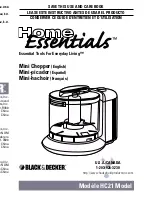
Setting Up The Processing
36
reduction feature stops mid and HF energy from over controlling the bass.
You can think of the bass-clip threshold in the same way regardless of what mode you use. Just think of it as
creating space for the other bands.
What mode should I use? If you can live with the delay then try both and see what sound you prefer. Talk radio
and softer formats such as easy listening usually sound better with the soft option. Dance and urban formats
can benefit from the added punch generated by the controlled distortion with the hard bass-clipper. If you prefer
the soft option but the extra delay makes it uncomfortable for your DJ's then you can consider using the lower
delay monitor output from the DSPXtra-FM as a studio feed.
The final clipper
The final clipper, used in the FM processing path is a sophisticated highly over-sampled peak limiter that incor-
porates distortion controlling techniques and has an embedded 15 kHz low-pass filter. This section of processing
is the last line of defence in the processing and is also the most critical part in the loudness/quality trade-off.
While each of the proceeding processing stages play a part in reducing the peak to average ratio of the audio
waveform none has the same effect on the peak to average ratio as the final clipper.
Great care is needed in setting the final clipper drive control. This control needs to be adjusted carefully and
only you can make the decision on the balance between loudness and quality. As you increase the drive you will
obviously obtain more loudness but at the expense of distortion. There is a fine line between artistic distortion
and distortion that your listeners will find uncomfortable to listen to, especially for extended periods of time. We
also suggest that you make final clipper drive adjustments in tandem with the multi-band clipper drive as what is
taken from or added from one can usually be made up for with the other.
The final clipper now has an additional control to help reduce IMD distortion. This clipper finesse control is an
additional program dependent mechanism that helps to reduce distortion by analysing the the level of IMD dis-
tortion and attempting to lower it by controlling how much the low frequencies can push the higher frequencies
into the clipper. The control is very subtle and its range has been limited to restrict the amount of control, pre-
venting pumping and a loss of loudness which would undo what we want to use the clipper for which is gaining
loudness.
You may not notice the effect of this control on all program material. When adjusting the clipper finesse control
we recommend that you turn the final clipper drive up past the point that you have it set at. This will make the
effect of the finesse control much more obvious and allow you to find the setting that sounds best for your for-
mat. Once the clipper finesse control is set you can back down the final clipper drive to the point that sounds
best knowing that the clipper finesse control has been set correctly to help keep the distortion down on difficult
program material.
There is also an overshoot control that trades off distortion between final clipper and composite clipper. Letting
more overshoots to be handled by composite clipper can sound a touch nicer, albeit at the expense of slight
contamination of the output spectrum.
Look-ahead limiter
A look-ahead limiter is used in the DSPXtra-FM to provide peak control for the DR path of processing. This is
not just a simple single band peak limiter. The DSPXtra-FM look-ahead limiter works in three bands to maximise
the quality of the processing while minimalising audible artefacts.
Each of the three bands has its own length delay line optimised to match that of the dual time constant gain con-
trol circuit controlling that bands level. By realignment of delays the look-ahead limiter like all of the DSPXtra-FM
processing maintains linear phase. You have access to the secondary (average responding) time constants for
each band and these controls allow an element of control over the texture of the look-ahead limiters processing.
The look-ahead limiter has its own fixed internal time constants which 'RIDE' piggyback on the secondary time
constants that you have access to. These fixed peak time constants are optimised for the band in question to
preserve transparency and peak control and are matched to the delay lines.
The look-ahead limiter has its own drive control adjustable over a +/- 6dB range. Like the multi-band clippers the
0dB reference point for the drive was chosen as a compromise between loudness and quality. As you increase
the drive more loudness will be obtained but at the expense of IM distortion which will start to make the audio
sound busy and packed.
The adjustable time constants in the look-ahead limiter also play a big role in affecting on air loudness and these
need to be adjusted carefully to prevent pumping when driving the look-ahead limiter more aggressively. Like
the dual time constants in the multi-band limiters you can adjust so that the peak time constants have most of
Summary of Contents for DSPXtra-FM
Page 63: ...www bwbroadcast com...
















































